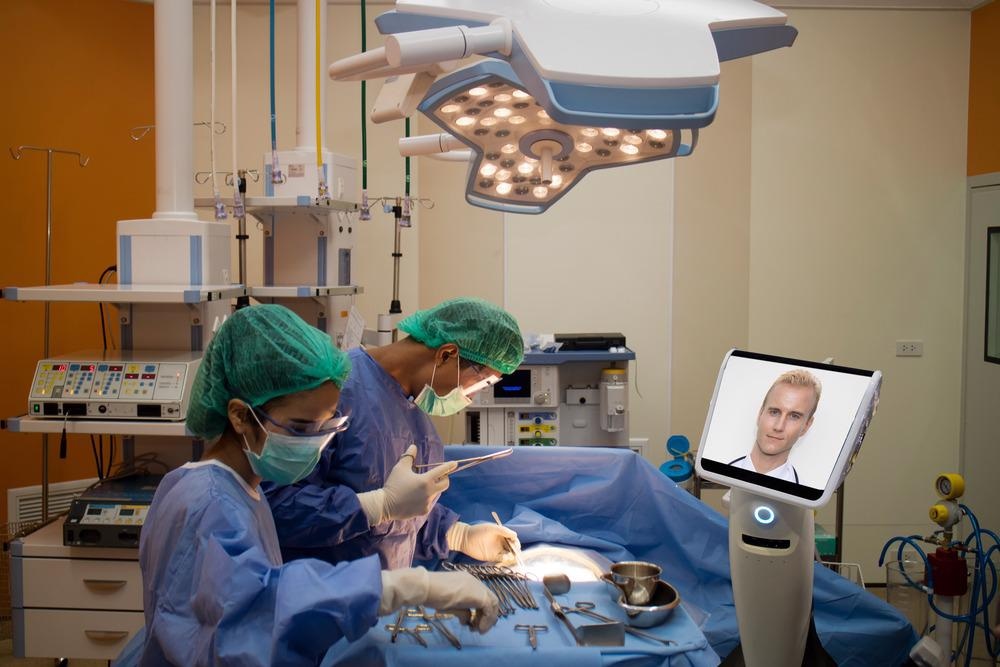Telepresence robots are remote-controlled robots with videoconferencing technology incorporated into them. This article will explore this subject, providing an overview and discussing some of the current research in the field.

Image Credit: MONOPOLY919/Shutterstock.com
Telepresence robots put the operator in an environment without the need for them to physically be there. They are controlled via smartphones, tablets, or computers and include elements such as speakers, microphones, screens, and video cameras. People can see and hear the operator and, consequently, the operator can see, hear, and interact with the remote environment.
The rapid growth of technologies such as 4G and 5G have made stable audio-visual-data transmission possible. Virtual and augmented reality technologies are also integral to the design of reliable and commercially viable telepresence robots alongside hardware components.
Essentially, telepresence technologies are assistive devices that mimic and replicate the senses of the human operator, allowing them to interact with the world as if they were there.
An Overview of the Current Telepresence Robotics Industry
Telepresence robots are used in or have potential applications for numerous important industries and activities. These include healthcare, social care, education, and commercial business sectors.
This robotics industry was valued at $165.4 million in 2020 and is projected to be worth $184.47 million by 2026, a growth of 11.53%.
The competitive landscape includes several players such as Blue Ocean Robotics, iRobot, Vecna, CtrlWorks Pte Ltd, and Wicron alongside non-commercial educational establishments. Toyota has also developed telepresence robots for the Tokyo Olympics.
The global COVID-19 pandemic has increased the demand for remote working technologies, and telepresence robots are well-placed to suit this need. Current projections of growth may be underestimating the true potential of the industry in years to come. The popularity of telepresence robots is increasing thanks to their cost effectiveness, savings on energy and time, and enhanced communication and presence.
What Are Some Examples of Telepresence Robotics?
The University of Colorado Boulder is looking into the possibility of utilizing telepresence robotics to allow students to attend classes remotely. Michigan State University used the Kubi and Double telepresence robots, in conjunction with video conferencing software, to achieve this aim as well; Double is a model made by startup Double Robotics Inc., a startup based in the USA, while Revolve Robotics manufactured Kubi.
Ohmni Robot by OmhniLabs is another popular, low-cost telepresence robot on the market. A wide-angle navigation camera allows the operator to see around the base of the unit, improving safety.
Ohmni Robot: Transform the Way You Communicate
Video Credit: OhmniLabs/YouTube.com
The head can move around from side to side (the Double robot has to rise and lower actions for the head), with other features of Ohmni, including real-time full-resolution zoom, which provides UHD 4K resolution of objects such as objects as whiteboards.
At the higher end of the spectrum of commercially available models is Ava from Ava Robotics. A feature of this model is intelligent, autonomous navigation. Operators specify the destination, and Ava will automatically move to it, avoiding any obstacles along the way.
Hospitals have been using telepresence robots for many years for telemedicine. Surgeons can advise during operations without physically being in the operating room, and physicians can carry out their rounds more efficiently and even monitor recently released outpatients. Travel times for specialists in the case of emergencies such as strokes are substantially reduced, increasing successful outcomes for patients.
Some models have enhanced features such as laser pointers, auto-navigation, and mapping features. There are many examples of telepresence robots that can be used in nearly any commercial or professional setting. One notable example in 2021 was the wide use of telepresence robots in the Tokyo Olympics. Toyota’s T-TR1 was used to allow people to attend events and interact with athletes virtually. The company has also been developing T-HR3, a life-sized humanoid robot, since 2017.
The Challenges Facing the Industry
Alongside regulatory considerations, challenges facing the telepresence robot industry include controllability, stability, maneuverability, and autonomy. Improvements to these issues are critical to ensure the safety of operation and reliability of systems.
Augmented reality is being explored to investigate human and robot interactive behaviors. Various research groups are exploring the possibility of digitally replicating the natural environment to improve the human operator's immersion and reaction to it. Simulations can also be used to inform design decisions.
Challenges also exist in combining functionalities such as adjustable height, system stability, low-speed control, and motion control for slopes and sudden inclines, though more work is required in these areas to improve the safety of the telepresence robot system.
The world is becoming more connected, and we are living through what has been widely termed as the 4th Industrial revolution. With a growing need for remote working and complementary technologies spurned on by the COVID-19 pandemic, the telepresence robot market is well-placed to meet the needs of the new century.
Continue reading: Telepresence Robot to Deliver Patient Care.
References and Further Reading
Mordorintelligence.com. (2021) Telepresence Robots Market | 2021 - 26 | Industry Share, Size, Growth - Mordor Intelligence. [online] Available at: https://www.mordorintelligence.com/industry-reports/telepresence-robots-market
Tuli, T.D. et al. (2021) Telepresence Mobile Robots Design and Control for Social Interaction International Journal of Social Robotics 13 pp. 877-886. Available at: https://doi.org/10.1007/s12369-020-00676-3
Telepresencerobots.com. (2021) What is a Telepresence Robot? | Telepresence Robot | Telepresence Robots. [online] Available at: https://telepresencerobots.com/what-telepresence-robot-and-what-can-they-do
Doublerobotics.com. (2021) Double Robotics - Telepresence Robot for the Hybrid Office. [online] Available at: https://www.doublerobotics.com/about.html
Cheung, D., Dykeman, T. and Fell, C., (2018) Using Telepresence Robots to Support Students Facing Adversity. [online] EDUCAUSE. Available at: https://er.educause.edu/articles/2018/6/using-telepresence-robots-to-support-students-facing-adversity
Graeme Massie (2021) Meet the army of robots that will help run the Olympic Games. [online] Independent.co.uk. Available at: https://www.independent.co.uk/sport/olympics/olympic-games-tokyo-robots-vehicles-b1884259.html
Disclaimer: The views expressed here are those of the author expressed in their private capacity and do not necessarily represent the views of AZoM.com Limited T/A AZoNetwork the owner and operator of this website. This disclaimer forms part of the Terms and conditions of use of this website.